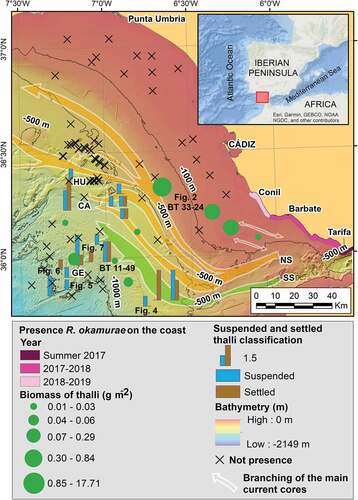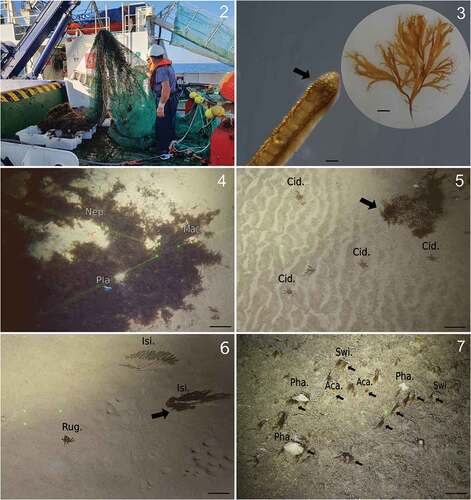Figures & data
Fig. 1. Map displaying the main deep currents and seafloor geomorphology of the Gulf of Cádiz, together with the coastal areas where Rugulopteryx okamurae has been detected from 2017 to 2019 according to García-Gómez et al. (Citation2020), and sampling stations where R. okamurae was detected in the oceanographic expeditions of this study (including quantitative and semi-quantitative annotations using a rank system). Suspended thalli classification (1, 1.0–4.9; 2, 4.9–9.9; 3, 9.9–30 thalli min–1); Settled thalli classification (1, 1.0%–14.9%; 2, 15.0%–29.9%; 3, 30.0%–74.9% of bottom coverage). References to figures are indicated on the map. The northern Spartel channel (NS), the southern Spartel channel (SS), the Cádiz channel (CA), the Huelva channel (HU) and the Gil Eanes channel (GE) are shown on the map. Black crosses indicate absence of R. okamurae. The digital bathymetric Model data products have been derived from the EMODnet Bathymetry portal – http://www.emodnet-bathymetry.eu. The main deep currents branches were obtained from Sánchez-Leal et al. (Citation2017).

Figs 2–7. Information about sample collection, morphology and accumulations of Rugulopteryx okamurae thalli (black arrows) on the deep-sea floor and on benthic fauna.

Table 1. Photosynthetic parameters calculated from Chlorophyll a fluorescence measurements (mean ± standard deviation, n = 6) of Rugulopteryx okamurae after 41 and 74 d of culture under either light (70 µmol photons m–2 s–1; 12:12 h photoperiod) or continuous dark conditions. No significant differences were found between light and dark conditions (p < 0.05). R > 0.99 was obtained for all curve fittings.
